England #2 (Portsmouth) 5-13
There has been no lack of things to do and places to see. We did take a short trip to the historic Naval town of Portsmouth where we stayed with Monika’s distant aunt and toured two of the most important restored British warships. The HMS Victory is a 104-gun first-rate battle ship of the Royal Navy. Launched in 1765, she is most famous as Lord Nelson’s flagship at the Battle of Trafalgar in 1805, which stopped the French and Spanish armada in their tracks and gave the British supreme control of the seas for a hundred years. With a crew of over 700, she could fire her 104 cannons at the rate of one shot every 90 seconds.
Horatio Nelson, 1st Viscount Nelson, KB (29 September 1758 – 21 October 1805) was a flag officer who became famous for his service in the Royal Navy, particularly during the Napoleonic Wars. He was noted for his inspirational leadership and superb grasp of strategy and unconventional tactics, which resulted in a number of decisive naval victories. He was wounded several times in combat, losing one arm and the sight in one eye. Of his several victories, the best known and most notable was the Battle of Trafalgar in 1805. (Wikipedia)
At the Battle of Trafalgar, Lord Nelson was shot and lost his life but he lived long enough to learn they had won. He was not buried at sea as would have been customary. To preserve his body for proper burial, they placed him in a barrel of rum. Lord Nelson was brought back to England for a state funeral at St. Paul’s Cathedral in London where he is entombed. His death at Trafalgar secured his position as one of Britain’s most heroic figures. Numerous monuments, including Nelson’s Column in Trafalgar Square, London, have been created in his memory and his legacy remains highly influential.
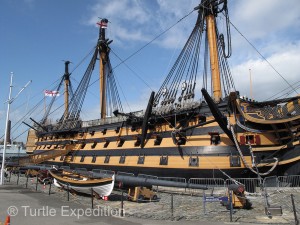
The HMS Victory is a 104-gun warship of the Royal Navy. Launched in 1765, she is most famous as Lord Nelson’s flagship.
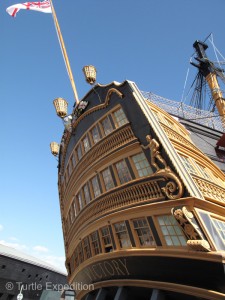
The Victory’s living quarters for the Captain, Commander and other officers looked like a three story apartment house.
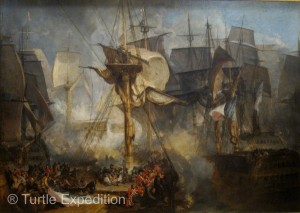
The Battle of Trafalgar in 1805 stopped the French and Spanish armada in their tracks and gave the British supreme control of the seas for a hundred years.
The equally impressive HMS Warrior, the first steel-clad warship, was built for the Royal Navy in 1859–60 and the pride of Queen Victoria’s fleet. She was the biggest and most powerful warship in the world at that time and had a profound effect on naval architecture. Yet within a few years, she was obsolete.
We really enjoyed touring this ship. It was authentically outfitted just like it was about to take off to a distant war. With a crew of over 700, she could fire her 104 cannons at the rate of one shot every 90 seconds. The soldiers slept in hammocks above the cannons. The center had a big kitchen with huge copper kettles. There was even livestock on board, well, a stuffed sheep and a few chickens….
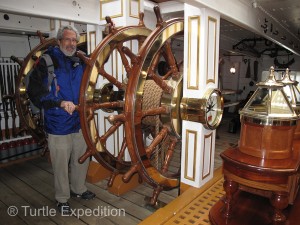
It needed eight men to steer the HMS Warrior, four on each wheel. One side moved the rudder and simultaneously, the second side took the slack out of the line as it stretched.
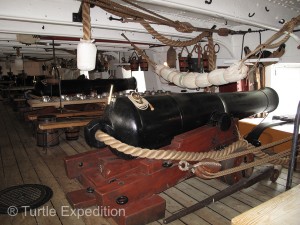
The HMS Warrior could fire its 104-gun arsenal at the rate of one shot every 90 seconds. There were 8 men to each cannon, each with a very specific job.
Unfortunately, the brand new museum for the third ship at the HM Naval Base, the HMS Mary Rose, was not quite open yet. Built in 1512, it had been the favorite battleship of King Henry VIII. In 1545, the English Tudor warship sank in the Solent, the straights north of the Isle of White, while leading the attack against a French invasion fleet.
The wreck of the Mary Rose was rediscovered in 1971 and salvaged in 1982 by the Mary Rose Trust in one of the most complex and expensive projects in the history of maritime archaeology. The surviving section of the ship and thousands of recovered artefacts are of immeasurable value as a Tudor-era time capsule. The finds include weapons, sailing equipment, naval supplies and a wide array of objects used by the crew. Many of the artefacts are unique to the Mary Rose and have provided insights into topics ranging from naval warfare to the history of musical instruments. (Wikipedia) They also found many human remains and the skeleton of a dog nicknamed “Hatch” because that’s where he was found.
She was armed with new types of heavy guns that could fire through the recently invented gun-ports. After being substantially rebuilt in 1536, she was also one of the earliest ships that could fire a broadside, although the line of battle tactics that employed it had not yet been developed. Several theories have sought to explain the demise of the Mary Rose, based on historical records, knowledge of 16th-century shipbuilding and modern experiments. However, the precise cause of her sinking is still unclear, because of conflicting testimonies and a lack of conclusive physical evidence. (Wikipedia)
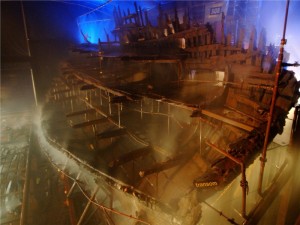
The HMS Mary Rose, King Henry VIII favorite warship, is now preserved in its own museum at Portsmouth, England



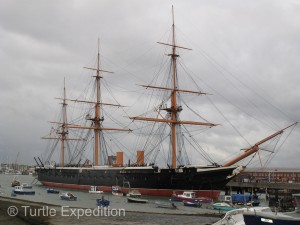





Leave a Comment